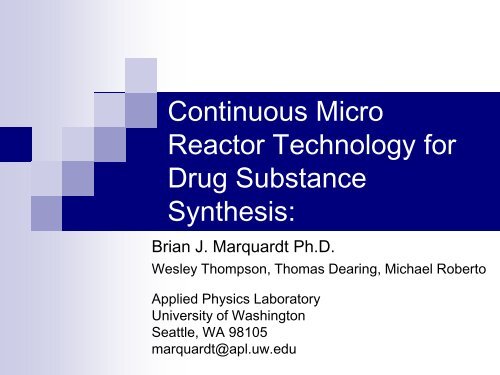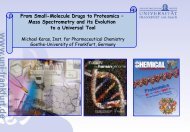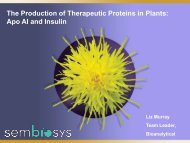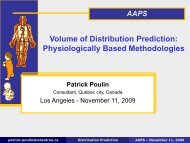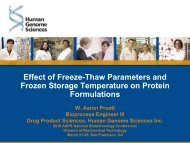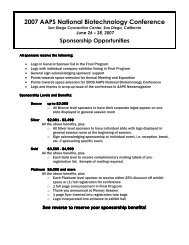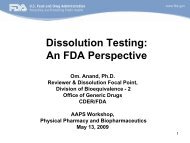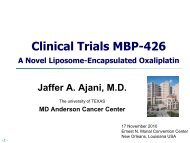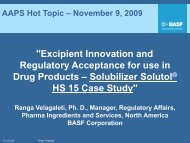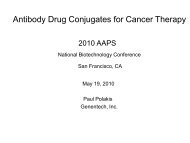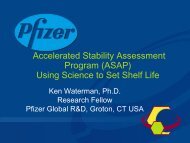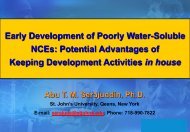Continuous Micro Reactor Technology for Drug Substance Synthesis:
Continuous Micro Reactor Technology for Drug Substance Synthesis:
Continuous Micro Reactor Technology for Drug Substance Synthesis:
Create successful ePaper yourself
Turn your PDF publications into a flip-book with our unique Google optimized e-Paper software.
<strong>Continuous</strong> <strong>Micro</strong><br />
<strong>Reactor</strong> <strong>Technology</strong> <strong>for</strong><br />
<strong>Drug</strong> <strong>Substance</strong><br />
<strong>Synthesis</strong>:<br />
Brian J. Marquardt Ph.D.<br />
Wesley Thompson, Thomas Dearing, Michael Roberto<br />
Applied Physics Laboratory<br />
University of Washington<br />
Seattle, WA 98105<br />
marquardt@apl.uw.edu
Analytical Sampling <strong>for</strong> Online Applications
Why Use Advanced Flow <strong>Reactor</strong>s<br />
High Throughput Experimentation For…<br />
Discovery and screening<br />
Process development<br />
Process optimization<br />
Process control<br />
Production<br />
• Eliminate chemical engineering production<br />
problems related to scaling up batch systems<br />
• Increase production through use of many parallel<br />
microreactors to achieve volume
Intensity<br />
Esterification Reaction Monitored by<br />
Example: Esterification of Methanol<br />
Raman Spectroscopy<br />
20000<br />
15000<br />
Acetic Acid + + Methanol<br />
ROI<br />
H +<br />
H +<br />
Heat<br />
Methyl Acetate + H 2 O<br />
Standard Raman spectra<br />
Acetic Acid<br />
Methanol<br />
Methyl Acetate<br />
10000<br />
5000<br />
0<br />
400 600 800 1000 1200 1400 1600 1800<br />
Raman Shift (cm -1 )
Relative Intensity<br />
Batch Runs at Different Temperatures<br />
250<br />
200<br />
150<br />
65º<br />
55º 45º<br />
35º<br />
25º<br />
15º<br />
100<br />
5º<br />
50<br />
• PCA analysis of the <strong>for</strong>mation of acetate monitored<br />
by Raman spectroscopy – reaction time 1.5 hours<br />
0<br />
0 30 60<br />
Reaction Time (min.)<br />
Total experiment time ~ 1 week (includes charging reactors, cleaning, …)<br />
90
<strong>Continuous</strong> Rxn. with Temp. Step<br />
Temp 40°C<br />
Temp 25°C<br />
• with residence time module<br />
• flow rate: 10.56 ml/min<br />
(residence time ~ 2.5 min)<br />
(25°C – 40°C)<br />
methyl<br />
acetate<br />
acetic<br />
acid<br />
• With control of flow reactor parameters and analytics, fast optimization is possible
Product Yield vs. Temperature<br />
PCA Analysis on data after mixing:<br />
1 st PCA scores Increase in reaction yield<br />
after each temperature step<br />
Range = 30-60°C<br />
• without residence time module<br />
• flow rate: 0.89 ml/min<br />
(residence time ~ 5 min)<br />
• 1 week of batch data reproduced in less than three hours by continuous flow
Result: Estimated Response Surfaces
Challenges To Using AF <strong>Reactor</strong>s<br />
• EDUCATION!!!!!!<br />
• Sampling and screening<br />
• Analytical characterization<br />
• Data handling<br />
<br />
<br />
Sensor fusing<br />
Multi-sensor modeling<br />
• Process modeling and feed back control<br />
(particularly if they are used <strong>for</strong> production)<br />
• Process optimization – move toward feed<br />
<strong>for</strong>ward control
Demonstrating QbD - Phase 1<br />
‣ Goal: to improve reaction development and<br />
optimization through the use of continuous glass flow<br />
reactors, NeSSI and analytics<br />
‣ Funded by the FDA to demonstrate the benefits of<br />
improved reactor design, effective sampling and<br />
online analytics to increase process understanding<br />
(QbD)<br />
‣ Partners: FDA, Corning, CPAC, Kaiser, Parker<br />
‣ QbD Project began November 2008<br />
‣ Process Reactions – June 2009
AF <strong>Reactor</strong> and Raman Analyzer<br />
• 4 channel, 785 nm Kaiser Optical Systems Rxn2 probes placed at different reactor zones
Chloro<strong>for</strong>mate Chemistry<br />
Organic Acid Chloride<br />
Organic Carbonate + dimer<br />
O<br />
O<br />
OH<br />
pyridine<br />
Cl + O<br />
HO<br />
toluène<br />
O<br />
O<br />
OH<br />
+<br />
N<br />
.HCl<br />
2-ethylhexyl chloro<strong>for</strong>mate butane-1,2-diol 2-ethylhexyl 2-hydroxybutyl carbonate<br />
OH<br />
O<br />
Cl<br />
+ O O<br />
O<br />
O O O<br />
O<br />
O<br />
O<br />
O<br />
2-ethylhexyl chloro<strong>for</strong>mate<br />
2-ethylhexyl 2-hydroxybutyl carbonate<br />
dimmer dimer<br />
• Carbonate and dimer <strong>for</strong>mation
Design of Experiments In<strong>for</strong>mation<br />
• 31 Experiments total<br />
Temperature steps<br />
Reaction with no toluene<br />
Changes in butanediol ratio<br />
Changes in pyridine ratio<br />
Propanediol instead of butanediol<br />
Simulated <strong>Reactor</strong> problems<br />
• Pump failure<br />
• Less heat exchange<br />
• Poor dilution of chloro<strong>for</strong>mate
Raman Analysis of AF <strong>Reactor</strong><br />
1<br />
2<br />
3 4<br />
• Monitor reaction with 4 channel 785 nm Raman system<br />
• NeSSI sampling systems (1-4) equipped with Raman ballprobes<br />
• Online GC also used as post quench online analyzer (4)
NeSSI Ballprobe - Raman/NIR/UV<br />
Ballprobe Specs.<br />
•Hastalloy c-276<br />
Ti, SS, Monel<br />
•Sapphire optic<br />
•Std. temp range:<br />
-40 – 350° C<br />
•Pressure:<br />
0-350 Barr<br />
Matrix Solutions: www.ballprobe.com
What is NeSSI<br />
• Industry-driven ef<strong>for</strong>t to<br />
define and promote a new<br />
standardized alternative to<br />
sample conditioning systems<br />
<strong>for</strong> analyzers and sensors<br />
• Standard fluidic interface <strong>for</strong><br />
modular surface-mount<br />
components<br />
• ISA SP76<br />
• Standard wiring and<br />
communications interfaces<br />
• Standard plat<strong>for</strong>m <strong>for</strong><br />
micro analytics
What does NeSSI Provide<br />
• Simple “Lego-like” assembly<br />
Easy to re-configure<br />
No special tools or skills required<br />
• Standardized flow components<br />
“Mix-and-match” compatibility between vendors<br />
Growing list of components<br />
• Standardized electrical and communication (Gen II)<br />
“Plug-and-play” integration of multiple devices<br />
Simplified interface <strong>for</strong> programmatic I/O and control<br />
• Advanced analytics (Gen III)<br />
<strong>Micro</strong>-analyzers<br />
Integrated analysis or “smart” systems<br />
Provides plat<strong>for</strong>m <strong>for</strong> coupling analytics to flowing systems
NeSSI Sampling System <strong>for</strong> <strong>Reactor</strong><br />
Raman Probe<br />
monitor<br />
clean<br />
bypass
NeSSI and Raman Probe Images
Raman Peaks of Interest <strong>for</strong> Rxn.<br />
Chloro<strong>for</strong>mate<br />
Toluene<br />
Carbonate<br />
Dimer<br />
Toluene
3D Plot of Raman Reaction Data (Low cm -1 )<br />
GC Results (%)<br />
Test R-OH 2EHCF R-Cl Carbonate Dimer<br />
1 1.17 0.00 0.26 96.17 2.40<br />
2 2.16 45.84 0.32 51.42 0.59<br />
Ch. 1<br />
Toluene<br />
Chloro<strong>for</strong>mate<br />
Toluene
DoE Run1 Channel 1 Data (<strong>Reactor</strong>)<br />
0.18<br />
0.12<br />
Run1Ch1LowPCA<br />
Density 1<br />
Density 2<br />
Density 3<br />
0.16<br />
Run1Ch1LowPCA<br />
Feed 1<br />
Feed 2<br />
Feed 3<br />
0.1<br />
0.14<br />
0.12<br />
0.08<br />
0.1<br />
0.06<br />
0.08<br />
0.04<br />
0.06<br />
0.04<br />
0.02<br />
0.02<br />
0<br />
20 40 60 80 100 120<br />
0<br />
20 40 60 80 100 120<br />
0.14 Run1Ch1LowPCA<br />
Pressure 1<br />
Pressure 2<br />
Pressure 3<br />
0.12<br />
0.12<br />
0.1<br />
Run1Ch1LowPCA<br />
Ambient Temp.<br />
Quench Temp.<br />
<strong>Reactor</strong> Temp.<br />
0.1<br />
0.08<br />
0.08<br />
0.06<br />
0.06<br />
0.04<br />
0.04<br />
0.02<br />
0.02<br />
0<br />
20 40 60 80 100 120<br />
0<br />
20 40 60 80 100 120
Normalized Signal Intensity<br />
Normalized Signal Intensity<br />
Reaction Profiles <strong>for</strong> 2 DoE Steps<br />
0.8<br />
0.7<br />
0.6<br />
GC Results (%)<br />
Test R-OH 2EHCF R-Cl Carbonate Dimer<br />
1 1.17 0.00 0.26 96.17 2.40<br />
2 2.16 45.84 0.32 51.42 0.59<br />
1<br />
0.8<br />
0.5<br />
0.4<br />
Test 1<br />
0.6<br />
0.3<br />
0.2<br />
0.1<br />
Test 2<br />
---- Carbonate<br />
---- Chloro<strong>for</strong>mate<br />
0.2<br />
0<br />
0 10 20 30 40 50 60 0<br />
Sample Number<br />
0.4
Project Summary and Future Directions<br />
• Data collected and organized<br />
17 days in Toulouse France<br />
• Analysis and Modeling<br />
Evaluation of various modeling<br />
protocols<br />
• PCA, MCR, ALS<br />
Calibrate to GC results (PLS)<br />
• Phase 2 of project<br />
Acquire reactor at CPAC<br />
Focus on reactor control<br />
Implement more sensors<br />
Scale-up vs. scale-out<br />
Real-time product work-up<br />
• Implement Models <strong>for</strong> Process<br />
Feedback Control
FDA Project - Phase 2<br />
Nov. 2010 – Oct. 2011<br />
• Process Scale Up and Control<br />
Chemistry<br />
• Determine, evaluate and test reactions in CF reactors<br />
Pharmaceutical industry relevant chemistry<br />
Emphasis on processing not specific chemistry<br />
• Determine CRF (Critical Response Factors) and Levels<br />
Sampling & DoE<br />
• Coupling analytics at mL and mL scales<br />
• Scalability<br />
Reaction monitoring w/online analytics<br />
• Reaction/Data Modeling<br />
Determine Control Mechanisms<br />
Initiation of Process Control
Chemtrix - Labtrix<br />
• Reaction optimization<br />
Features<br />
• Syringe pumps<br />
• Automated sample collection and<br />
control<br />
• Tests at pressures of 25 bar and<br />
temperatures of -15 to 195°C<br />
• Standard interchangeable reactors<br />
• Catalyst reactors:<br />
Courtesy Paul Watts, University of Hull, UK<br />
• Labtrix plat<strong>for</strong>m will be the low volume reactor plat<strong>for</strong>m <strong>for</strong> our Phase II FDA project
Corning ® Advanced-Flow TM LF<br />
Low-Flow Capability (1-10 mL/min)<br />
Corning has introduced a reduced<br />
flow-rate reactor that retains the<br />
outstanding mixing and heat<br />
exchange per<strong>for</strong>mance of its<br />
Advance-Flow TM glass reactors<br />
while providing:<br />
• Low internal volume (2 mL flow)<br />
• High flexibility<br />
• Metal-free reaction path<br />
• Scalability<br />
• Compatibility with analytics<br />
• T, Flow and Pumping control<br />
• LF plat<strong>for</strong>m will be the larger reactor plat<strong>for</strong>m <strong>for</strong> our Phase II FDA project
<strong>Reactor</strong> with NeSSI and Analytics at CPAC
Esterification of Benzoic Acid and<br />
Subsequent Hydrolysis
Swern Oxidation – 3 step rxn
Phase 2 – QbD Envisioned<br />
• Process Optimization<br />
Scale Up Versus Scale Out<br />
• Transfer chemistry from mL scale to mL scale<br />
• Full DoE at small scale and transfer <strong>for</strong> fast optimization at larger<br />
scale<br />
Development of Generic Strategy<br />
• define selection of the best analytical tools, processing methods,<br />
and model designs in a short time frame<br />
• Speed optimization of new chemistry with CF reaction methods<br />
• <strong>Continuous</strong> Process Control<br />
Initiate control protocols utilizing analytics <strong>for</strong> improved product quality<br />
Evaluate continuous post-reaction workup steps – Phase 3<br />
• Purification<br />
• Desolvation<br />
• Separation
Mettler Toledo - React-IR,
Thermo/C2V Fast <strong>Micro</strong>-GC<br />
http://www.c2v.nl/ as well as http://www.thermo.com
Conclusions and Projections<br />
• The initial demonstration phase of the QbD project successfully<br />
demonstrated the capability of effective sampling coupled with<br />
higher order analytics to provide a real-time view of a chemical<br />
process<br />
• The second phase builds on the sampling and analytical methods<br />
developed in phase 1 and models the sensor data in real-time to<br />
per<strong>for</strong>m fast and efficient optimization of new chemistries using DoE<br />
and low volume continuous reactors (Chemtrix system)<br />
• Once the chemistry has been optimized and validated at the<br />
microliter scale, that chemistry will be scaled up to the mL scale<br />
(Corning LF system) and optimized using an optimal DoE<br />
• The final aspect of phase 2 will be to integrate the real-time analytics<br />
into a control algorithm <strong>for</strong> continuous feedback control of the<br />
system <strong>for</strong> consistent and validated quality production
Thanks<br />
• U.S. Food and <strong>Drug</strong><br />
Administration<br />
Moheb Nasr<br />
Christine Moore<br />
Sharmista Chatterjee<br />
David Morley<br />
• Corning Glass<br />
• Parker<br />
• Kaiser Optical Systems<br />
• CPAC<br />
• University of Washington<br />
• Applied Physics Lab<br />
• La Maison Européenne des<br />
Procédés Innovants (MEPI )<br />
U.S. Food and<br />
<strong>Drug</strong> Administration<br />
MEPI


